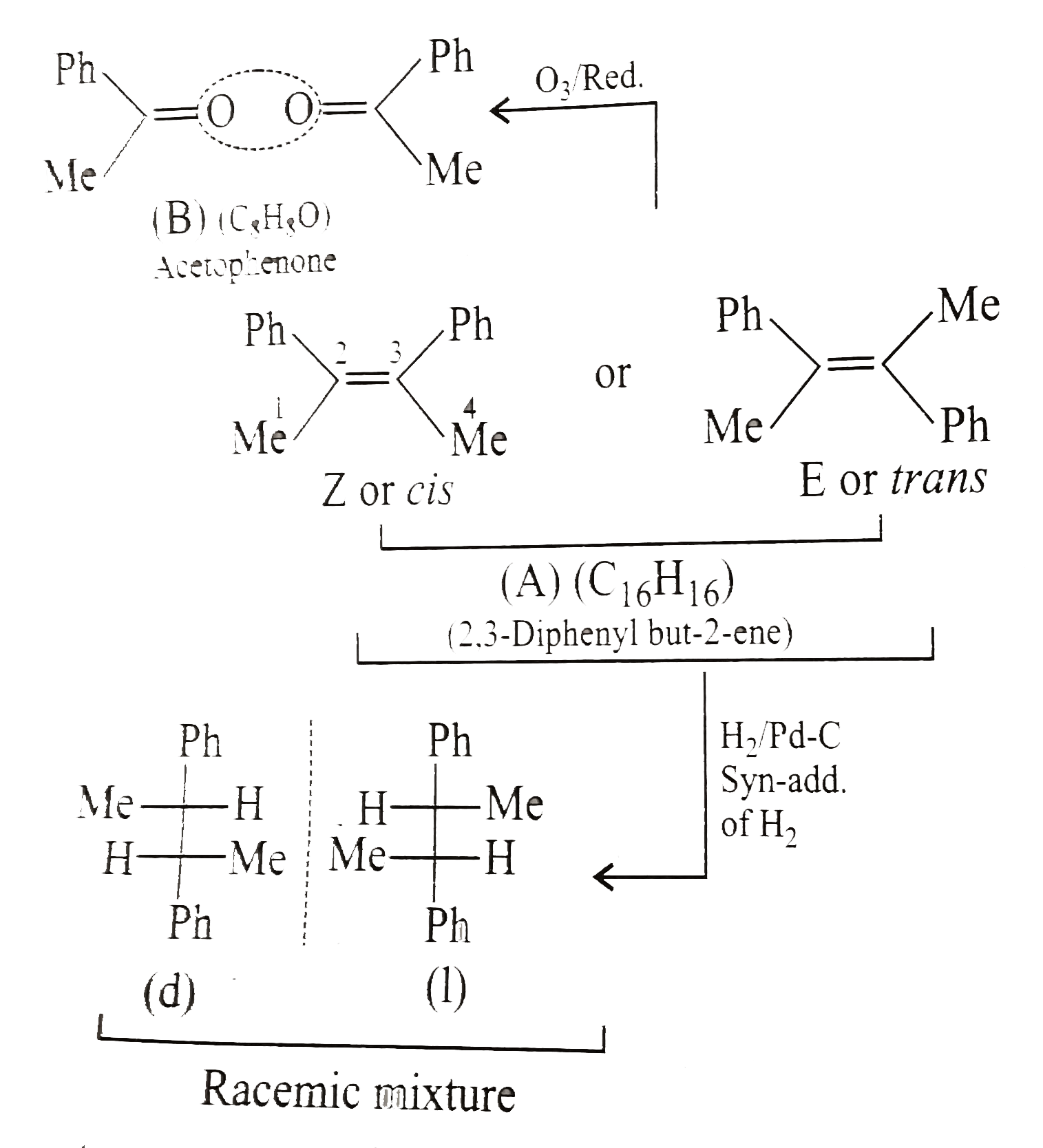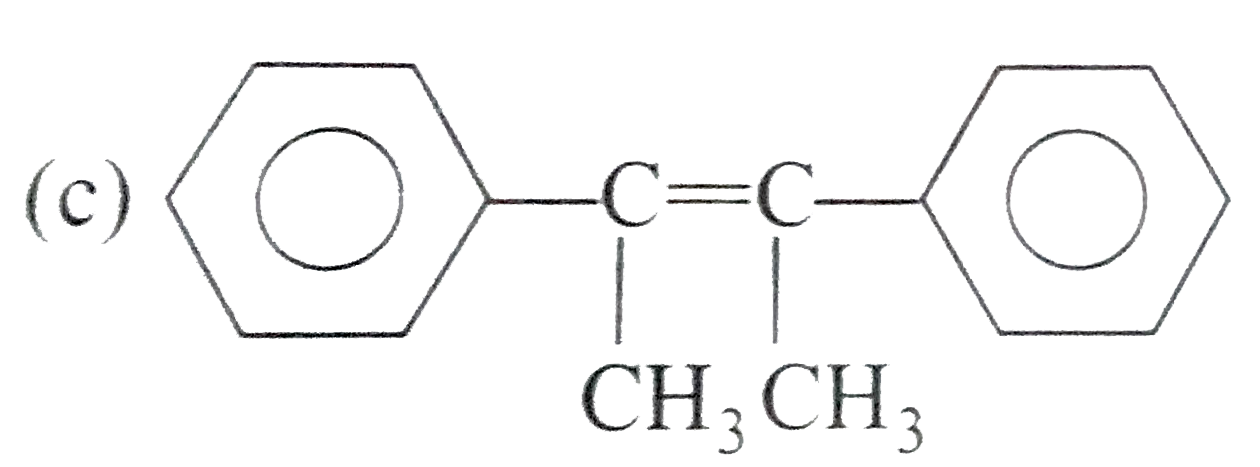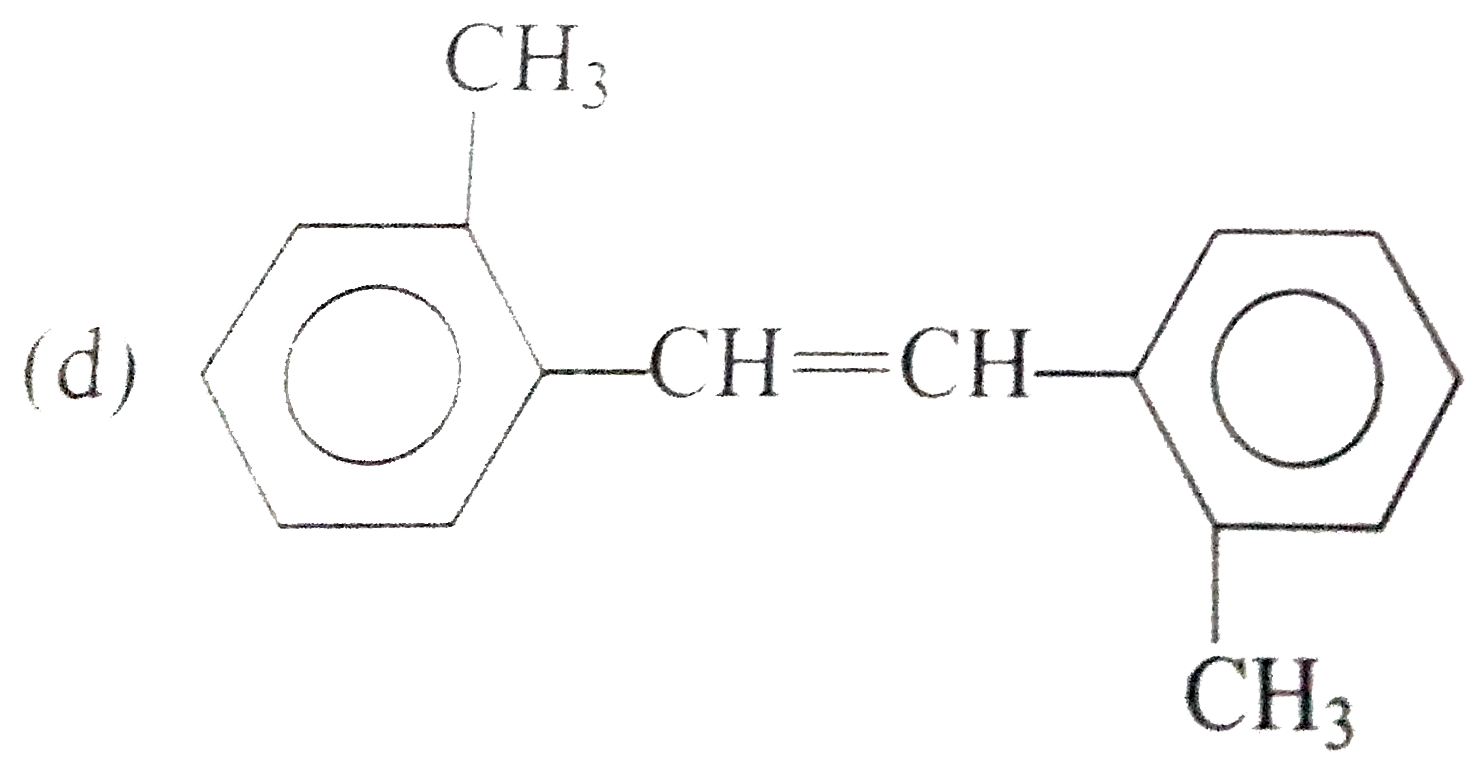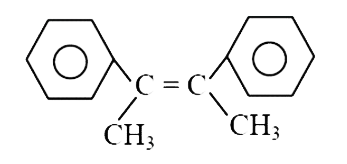An alkene (A)C16H16 on ozonolysis gives only one product (B)(C8H8O). Compound (B) on reaction with NaOH/I2 yields sodium benzoate. Compound (B) reacts with KOH/NH2 yielding a hydrocarbon (C8H10). Write the structures of compounds (B) and (C). Based on this information, two isomeric structures can be proposed for alkene (A). write thair structures and identify the isomer which on catalytic hydrogenation (H2+Pd+C) gives a recemic mixture.
Alkene (A) is symmetrical since on ozonolysis gives 2mol of (B) (C8H8O).
DU in B=(2nC+2)−nH2=(2×8+2)−82=5∘
Since, C:H≈1:1, B contains benzene ring. Moreover, B gives iodoform test, it must contain (MeCO−) group). So the structure of B may be (PhCOMe) (acetophenone).
Reactions:

Topper's Solved these Questions
- REDUCTION AND OXIDATION REACTION OF ORGANIC COMPOUNDSBOOK - CENGAGE CHEMISTRYCHAPTER - REDUCTION AND OXIDATION REACTION OF ORGANIC COMPOUNDSEXERCISE - SUBJECTIVE TYPE
3 Videos
- REDUCTION AND OXIDATION REACTION OF ORGANIC COMPOUNDSBOOK - CENGAGE CHEMISTRYCHAPTER - REDUCTION AND OXIDATION REACTION OF ORGANIC COMPOUNDSEXERCISE - Exercise (Assertion And Reasoning)
10 Videos
- QUALITATIVE INORGANIC SALT ANALYSISBOOK - CENGAGE CHEMISTRYCHAPTER - QUALITATIVE INORGANIC SALT ANALYSISEXERCISE - Viva Voce Questions And Part-C (Analysis Of Cations)
42 Videos
- SOLID STATEBOOK - CENGAGE CHEMISTRYCHAPTER - SOLID STATEEXERCISE - Ex 1.2 (Objective)
9 Videos
Similar Questions
An alkene (A) C10H10 on ozonolysis gives only one product (B) C8H8O. Compound (B) reduction with NaOH/I2 yields sodium benzoate. Compound (B) reacts with KOH/NH2NH2 yielding a hydrocarbon (C) C8H10. Write the structures of compound (B) & (C). Based on this information two isomeric structures can be proposed for alkene (A). Write their structure and identify the isomer which on catalytic hydrogenation (H2/Pd−C) gives a racemic mixture.
View SolutionAn alkene (A) C16H16 on ozonolysis gives only one product (B) C8H8O. Compound (B) on reaction with NaOH/I2 yeilds sodium benzoate. Compound (B) reacts with KOH/NH2NH2 yielding a hydrocarbn (C)C8H10. Write the structure of compound (B) and (C). based on this information to isomeric structures can be proposed for alkene (A). write their structure and identify the isomer which one catalytic hydrogenation (H2/Pd−C) gives a racemic mixture
View Solution
Knowledge Check
An alkene (A) C16H16 on ozonolysis gives only one product (B) C8H8O. Compound (B) on reaction with NH2OH,H2SO4 and heating gives N-methyl benzamide. The compound (A) is:
A B
B C
C D
D
An alkene (A)C16H16 on ozonolysis gives only one product (B)(C8H8O). Compound (B) on reaction with NH2OH followed by reaction with H2SO4,Δ gives N - methyl benzamide the compound 'A' is -
A B
B C
C D
D
An alkene (A) C10H16 on ozonolysis gives only one product (B) C8H8O. Compound (B) on reaction with NaOH/l2 yiedls sodium benzoate. Compound (B) reacts with KOH/NH2−NH2 yielding a hydrocarbon ( C ) C8H10. Write the structure of (B) and ( C ) Based on this information give two isomeric structures of (A).
View SolutionAn alkane (A) C16H16 on ozonolysisi gives only one products (B) C8H8O. Compound (B) or reaction with NaOH/I2 yields sodium benzoate. Comopund (B) reacts with KOH/NH2NH2 yielding a hydrogen (C) C8H(10). Write the structures of compounds (B) and (C). Based on this infromation two their structures and identify the isomer which on catalytic hydrpgenation (H2/Pd−C) gives a racemic mixture.
View SolutionAn alkene (A)C16H16 on ozonolysis gives only one product (B)(C8H8O). Compound (B) on reaction with NH2OH followed by reaction with H2SO4,Δ gives N - methyl benzamide the compound 'A' is -
View SolutionPrimary alkyl halide C4H9Br (A) is reacted with alcoholic KOH to give compound (B). The ompound (B) is reacted with HBr to give (C) which is an isomer of compound (A). Write the structures of the compounds (A), (B) and (C).
View SolutionC(C6H12), and optically active dydrocarbon which on catalytic hydrogenation gives an optically inactive compound, C6H14.
View SolutionCompound (A) C5H8O2 liberated CO2 on reaction with sodium bicarbonate. It exists in two forms neither of which is optically active. It yielded compound (B) C5H10O2 on hydrogenation. Compound (B) can be separated into enantiomorphs. Write structures of (A) and (B).
View Solution
